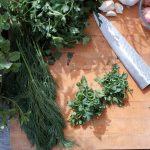Mastering the Art of Cooking with Herbs: Transform Your Dishes Instantly
Sweet Treats With an Herbal Twist
Herbs can transform standard desserts into gourmet creations. Infusing custards or panna cottas with herbs such as rosemary or thyme offers a subtle complexity. By gently steeping herbs in milk or cream, traditional desserts take on a sophisticated edge.
Mint can breathe new life into fruit salads or sorbets, providing a fresh and invigorating contrast to sweet fruits. Lime and mint work beautifully in sorbets, creating a refreshing dessert perfect for warmer days. Basil can enhance berry desserts with its sweetness, adding intrigue to sorbets or compotes.
Lavender can be an exceptional addition to honey-based desserts. Its floral notes blend seamlessly with the sweetness of honey, creating a luxurious flavor. Sage can introduce a deeper warmth to caramel dishes, enriching their complexity and showcasing the versatility of herbs in sweet contexts.
Herbs as Garnishes and Finishing Touches
Adding herbs as garnishes and finishing touches can elevate a dish from ordinary to extraordinary. Fresh herbs provide visual appeal and offer a burst of flavor that enhances the overall culinary experience.
Garnishing Techniques
Effective garnishing begins with selecting fresh herbs. Vibrant colors and crisp textures suggest optimal flavor. Chives, with their delicate onion-like taste, can be snipped finely to provide a subtle yet flavorful accent.
Basil leaves add a touch of freshness and aesthetic green to salads and pastas. For balance, it’s essential to consider contrasting colors and textures. Delicate herbs should be added at the last moment to preserve their vibrant appearance and aroma.
Balancing Flavors With Fresh Herbs
Fresh herbs play a crucial role in flavor balance. Basil, with its sweet and slightly peppery taste, can complement the tanginess of tomatoes. Chives, with their mild onion flavor, blend effortlessly into creamy dishes, enhancing without overwhelming other ingredients.
Adding herbs just before serving ensures that the pronounced flavors remain intact. When using strong herbs, moderation is key to avoid overpowering the dish. Employing herbs like chives and basil allows chefs to create complexity and depth, enriching the dining experience with fresh and fragrant contrasts.
Building Your Herbal Recipe Book
Crafting a personal herbal recipe book is a journey of discovery and innovation. This process involves capturing creative culinary ideas and organizing them into a practical and inspirational resource. It fosters a deeper appreciation for the flavors and benefits that herbs contribute to various dishes.
Documenting Herb-Inspired Creations
When documenting herb-inspired creations, precision and clarity are essential. Every recipe should include detailed instructions, from preparation to serving, to ensure consistent results. It is also important to list all necessary ingredients with specific amounts and any unique techniques used in the preparation.
Including notes on the herb’s flavor profile and its impact on the dish can be beneficial. This not only aids in recreating the dish but also educates on the herb’s culinary uses. Photographs can enhance the documentation, offering visual guidance and inspiration. Over time, this collection becomes a treasure trove of aromatic possibilities, each entry an opportunity to refine and share culinary skills.
Curating a Personal Herb Cookbook
Curating a personal herb cookbook requires thoughtful organization. Grouping recipes by meal type or the primary herb allows for easy navigation and exploration. Categories can include appetizers, main courses, and desserts, or focus on herbs like basil, rosemary, and cilantro.
It’s helpful to design a user-friendly layout, perhaps with a contents section or index. This enhances the practicality of the cookbook, making it easier to locate recipes. Including sections for notes or personal reflections encourages continuous learning and adaptation. This evolving document not only preserves culinary traditions but also inspires experimentation and creative expression with herbs in everyday cooking.



